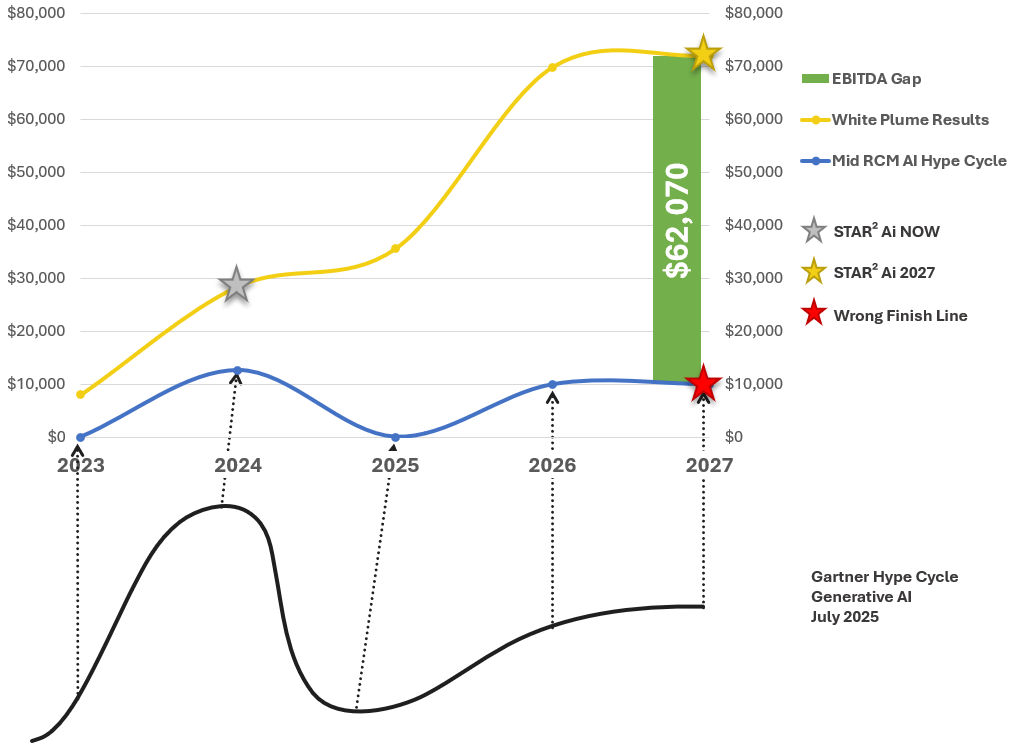Ambulatory Rev Cycle AI and the Gartner Hype Cycle:
Don’t Race to the Wrong Finish Line
The Wrong Finish Line (Part II)

Every breakthrough technology rides the Gartner Hype Cycle: from inflated promises, through disappointment, and eventually toward real productivity. Today, Ambulatory Revenue Cycle AI is perched at the very top of that cycle: the Peak of Inflated Expectations.
For physicians, coders, and healthcare leaders, the stakes couldn’t be higher. The story we tell ourselves about AI now will determine whether it becomes a threat or a breakthrough.
The Coder Question and the 250,000 Jobs on the Line
The AAPC estimates there are roughly 250,000 coders in the U.S. Yet even within the AAPC, voices are acknowledging AI’s disruptive potential. In fact, some speculate that AI could eliminate coding jobs entirely — projecting a collapse from 250,000 coders to zero at the hype cycle’s peak (Sidecar analysis).
It’s easy to see how this narrative takes hold:
- AI promises “full automation.”
- Business leaders see cost savings by reducing coder salaries.
- Consultants predict disruption on a massive scale.
But as we’ve learned before, chasing productivity or job elimination is a race to the wrong finish line.
The Hype Cycle Applied to Coding Jobs
Let’s plot the coding profession against the Gartner Hype Cycle:
- Coding Jobs Today: ~250,000
- Peak of Inflated Expectations: Predictions of 0 coding jobs (“AI replaces coders entirely”)
- Trough of Disillusionment: Reality sets in; coding jobs rebound toward 250,000
- Plateau of Productivity: A new balance emerges — closer to 20,000 coders, supervising AI and optimizing outcomes rather than coding from scratch
This arc has profound implications:
- For coders, it means the profession isn’t going away — but it is transforming.
- For physicians and physician shareholders, it means betting on cost-cutting by eliminating coders will backfire. AI will only amplify bad outcomes if it’s pointed at the wrong finish line.
Eliminating Coders Is the Wrong Finish Line
Physician groups tempted by the idea of “no coders” may see short-term savings — but long-term damage.
Why? Because AI accelerates whatever goal it’s aimed at. If the goal is cutting coder headcount, AI will help you get there faster — but at the cost of higher denials, missed revenue, and weaker outcomes.
This isn’t just bad for coders. It’s bad for physician shareholders, whose enterprise value depends on sustainable revenue capture.
As we showed in Goldilocks and the Three Coders, productivity alone isn’t the finish line. Total outcomes matter more. And AI doesn’t change that equation — it only makes the race faster.
Optimizing STAR² Ai Is the Right Finish Line
The answer isn’t eliminating coders. It’s optimizing what coders and AI can achieve together.
White Plume’s STAR² Ai measures the true total outcome of coding performance, including:
- Denial prevention
- Charge lag
- Net revenue captured
- Productivity (EPH)
When organizations optimize on STAR² Ai instead of productivity or headcount reduction, they maximize enterprise value.
And here’s the kicker: White Plume is already years ahead of the game. While the industry is just entering the hype cycle, White Plume clients are already seeing outcomes that outperform the projected Plateau of Productivity.

EBITDA Impact per Physician per Year
The Takeaway: Don’t Be Fooled by the Hype
We are at the top of the Ambulatory Rev Cycle AI hype cycle. Some predict a world with zero coders. Others believe AI will magically solve revenue cycle inefficiencies overnight. Both are wrong.
The reality is more nuanced:
- Coders won’t disappear; they’ll evolve into supervisors and editors.
- Physicians won’t win by cutting headcounts; they’ll win by maximizing total outcomes.
- AI will separate winners from losers based on where it’s aimed.
Don’t race to the wrong finish line. Optimize on STAR² Ai with White Plume and start achieving outcomes that the rest of the industry won’t see until long after the hype dies down.







